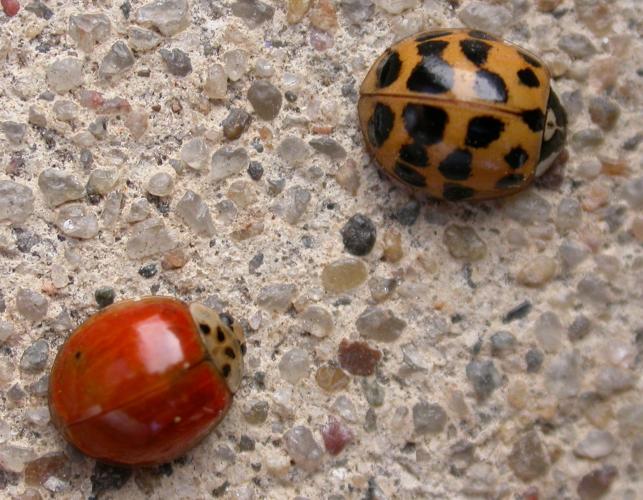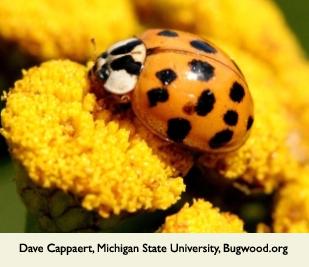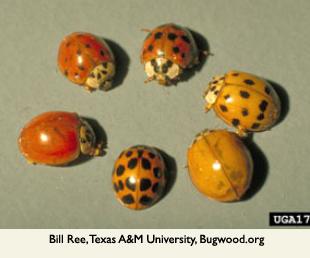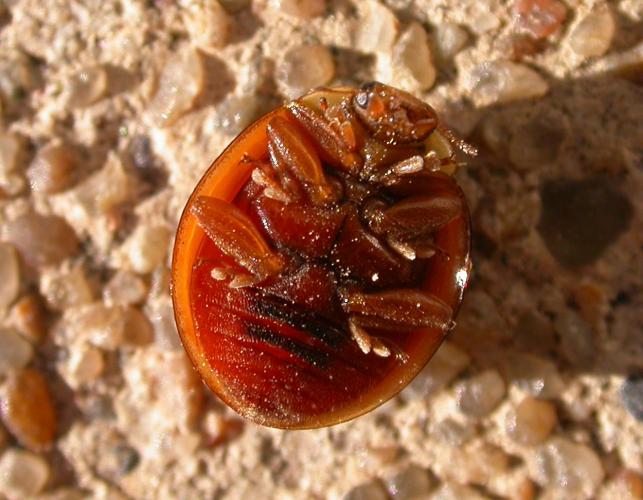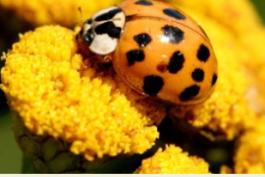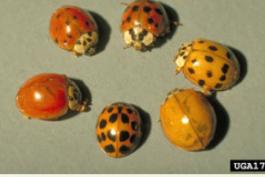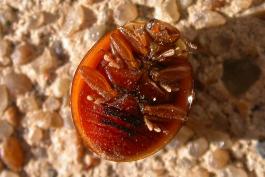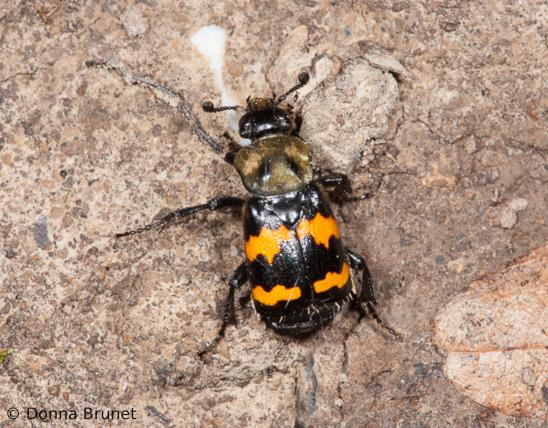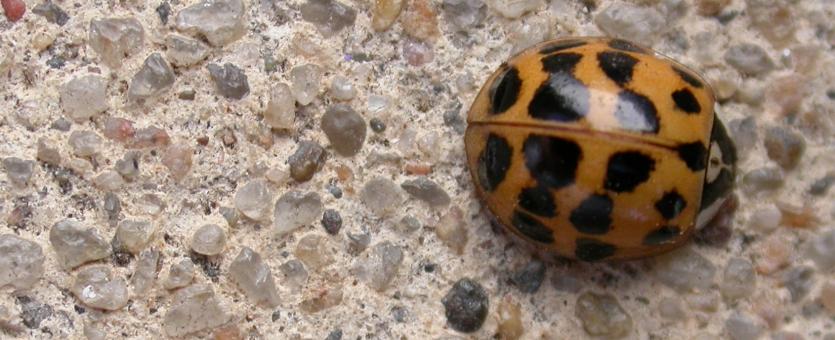
The multicolored Asian lady beetle (MALB), an introduced species, has many color forms and patterns. Most people know a lady beetle (a.k.a. "ladybug") when they see one, so the trick is to learn how to tell this species from our many native lady beetles. Despite the amazing variety of color patterns, most individual Asian lady beetles share the following traits:
- The elytra (shiny hard wing covers) are usually tan, orange, or red.
- There may be many (up to 19), some, or no black spots.
- The elytra have a distinctive shape: flattened and flared in back, but steep in front (like "squared shoulders").
- The pronotum (plate behind or above the head) is usually white with four black spots, which sometimes join and form a W.
- The center of the face is usually white.
- This is a relatively large species of lady beetle.
The larvae of this species are not as variable as the adults. Like other lady beetle larvae, they don't look much like beetles; instead, they resemble segmented, 6-legged lizards or alligators. Asian lady beetle larvae are very dark gray with rows of 2-branched spines; they also have a distinctive pattern of orange markings. They look slightly different as they grow, molt, and go through different juvenile stages, but the branched spines are distinctive.
Similar species: There are nearly 500 other species of lady beetles (family Coccinellidae) in North America north of Mexico. You would probably not recognize many of them as lady beetles, since not all are red with black spots: some are all black, some are black with red spots, some are brown, some are black-and-white checkered, and so on.
Also, the multicolored Asian lady beetle is not the only lady beetle introduced from elsewhere in the world. For example, at least two other species in genus Harmonia have been established in North America, but those two are apparently not established in our state.
Learn more about lady beetles (family Coccinellidae) as a group on their family page.
Length: about ⅜ inch.
Statewide.
Habitat and Conservation
The Asian lady beetle was imported to America to help control aphids and other crop pests, especially between the 1960s and 1990s in southern states, but elsewhere as well. By the late 1980s, it appeared to have naturalized and in the 1990s was expanding its range. It generally is found only in agricultural and city environments, but in these places, it is very common. It is now well established and has become a nuisance. They often enter homes in large numbers as they seek shelter in late autumn. They emit a foul-smelling chemical when threatened.
Food
The larvae of this species devour a wide range of small, sap-sucking or soft-bodied insects, including aphids, scale insects, mealybugs, plant mites, and thrips. They also eat the eggs of moths and butterflies. It appears that, late in the growing season, these beetles may eat the sweet juices that ooze from damaged, late-autumn grapes when the availability of prey insects may be declining, but they do not directly attack the fruit or reduce the crop yield.
Life Cycle
Like other lady beetles, this species hatches from an egg, goes through immature stages as it eats and grows, then pupates to become a winged, sexually mature adult. There are four juvenile stages, each of which can look different from the others. Then they enter an inactive, shell-covered pupal stage, while they undergo metamorphosis, and later emerge as adults.
Human Connections
Introduction of the MALB, by many measures, was a huge success, because this species has proven to be a helpful biological control against crop pests of pecans, apples, citrus, alfalfa, corn, cotton, tobacco, wheat, and soybeans.
On the other hand, Asian lady beetles are not welcome when they swarm into homes in late summer and fall. Once indoors, they buzz around living room lights at night, emit a unique foul odor when disturbed, and excrete a yellow, staining fluid on walls and fabrics.
Researchers have found that the swarming of this species is especially intense on warm, sunny fall days that occur right after a cool, overcast period. They seem especially attracted to bright, sunlit sides of houses in afternoons, and congregate the most in places with strong contrasts between light and dark-colored surfaces, such as dark shutters on a light house.
To exclude MALBs from a building, use caulk or similar sealant to seal cracks around windows, siding, utility pipes, and other possible entry points. To remove these insects from your home, vacuuming them is probably better than a broom and dustpan, as the latter will cause the insects to secrete their stinky, staining liquid.
Missouri's grape growers have discovered that these beetles take shelter in grape clusters late in the season. Then, when the grapes are harvested, the beetles, crushed along with the fruit, cause "off" flavors in the finished wine. The problem is worst with grapes that are harvested late in the season, including Nortons and grapes intended for late-harvest dessert wines.
Fortunately, Asian lady beetles are not known to be particularly injurious to humans: they do not transmit diseases, nor do they possess venom. They do not destroy clothing, wood, or food. In large numbers, however, for people who are predisposed they can trigger allergy or asthma symptoms. In general, people should avoid touching their eyes or noses after handling these insects.
Ecosystem Connections
Unlike most of our native insects, this nonnative species seems to have few natural enemies in our country. The foul-smelling fluid they secrete seems to deter many predators. There are a few species of wasps and flies that parasitize them, and they can contract a fungal illness, but it is not generally lethal for them.
When an insect is not eaten by predators (such as larger insects or spiders, or birds, amphibians, reptiles, fish, or mammals), it does not pass the nutrients in its body up the food chain. Also, it lacks the "checks" on its population that predators provide. Thus its populations are limited only by the amount of food available. This species competes with native lady beetles for the same food.
This species has several qualities that have branded it as "invasive" in several parts of the world. As a voracious predator, it can outcompete other, native lady beetles for food. It can survive (and even introduce) diseases that native lady beetles are not resistant to. In the United Kingdom, this species is considered invasive, and its presence has been contributing to the decline of a number of native lady beetle species. Researchers in Europe are hoping to find fungi, mites, or parasitic roundworms that might help to control populations of Asian lady beetles.
